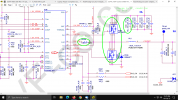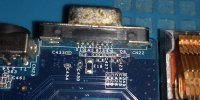Hi, everyone!
I'm having a video problem with my Sony Vaio VGN-C240FE... I've been 'scoping onto the motherboard power supplies, and I found that the +1.8 volts Mem. Pwr. Supply is not showing any signal on its power choke coil (PL5 on the schematic). Well, that signal comes from the IC SC486 (PU8), but I'm not quite sure where to test the in and out voltages, since it has 3 outputs and the input should be 12-13 pins VTTIN according to the datasheet, which differs with the schematic (12-13 pins +1.8 VOUT).
Could you please help me understand how this IC really works in order to give that +1.8 volts the memory needs to work?
Thanks in advance!
Alex.
I'm having a video problem with my Sony Vaio VGN-C240FE... I've been 'scoping onto the motherboard power supplies, and I found that the +1.8 volts Mem. Pwr. Supply is not showing any signal on its power choke coil (PL5 on the schematic). Well, that signal comes from the IC SC486 (PU8), but I'm not quite sure where to test the in and out voltages, since it has 3 outputs and the input should be 12-13 pins VTTIN according to the datasheet, which differs with the schematic (12-13 pins +1.8 VOUT).
Could you please help me understand how this IC really works in order to give that +1.8 volts the memory needs to work?
Thanks in advance!
Alex.


